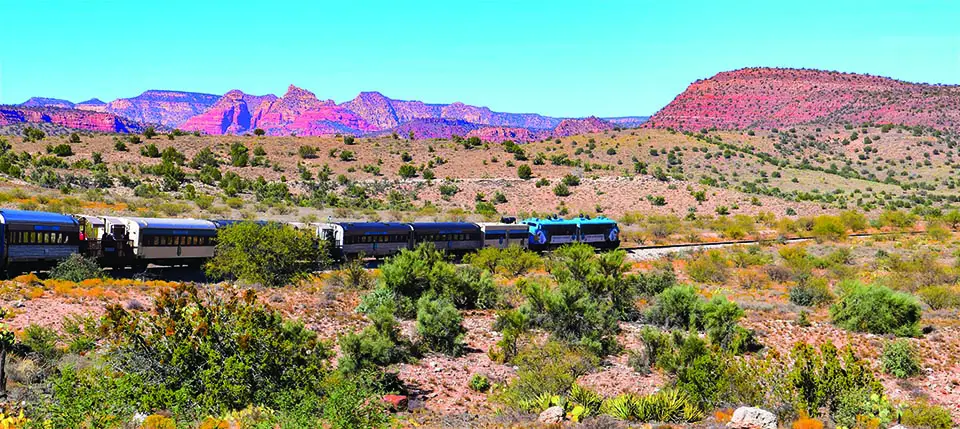I fear it’s downright cliché to say that passengers on the Verde Canyon Railroad in Northern Arizona get to see some of the most beautiful landscape in the West, but they do.
We anticipated some Kodak moments when we made reservations for the 3.5-hour, 40-mile round trip during the second week of November, but our expectations were exceeded.
Even though the autumn countryside, according to our car attendant, Candace Wirts, “was probably at the peak a week or two ago,” the terrain that passed as we rolled north/northwest out of Clarkdale (25 miles southwest of Sedona) was pretty stunning.
As we snaked through the Verde Canyon, often paralleling the river that created it, we marveled at the rising red-rock cliffs that lorded over all; the leafy cottonwood trees that had transitioned to a brilliant saffron; and a meandering river that often reflected its surrounding environment.
Every bend brought another camera-worthy scene and passengers both inside the club cars and those in the open-air observation cars were transfixed.

Two vintage locomotives pulled us through the Prescott and Coconino national forests, traversed trestles and bridges, and plunged into a 680-foot-long tunnel (Hint: The engineer blows the whistle about 30 seconds before the train reaches the tunnel. If you aren’t already there, move to the nearest open-air car. It’s a kick to ride through the tunnel in an outside car).
The rail trip into the Verde Canyon commences daily at 1 p.m., but come early to see the museum.
The railroad follows pandemic protocol: mandatory masks and temperatures for passengers and staff; an amped-up sanitizing routine; food served in disposable containers; and operation at 50% capacity.
Despite working six days a week – autumn is peak season – Wirts never tires of the scenic spectacular.
“Oh my gosh, no,” said the resident of nearby Cottonwood, who has worked for the railroad since 2011. “I never get tired of the scenery. You see something different each day. This is like a mini-Grand Canyon.”
Wirts, who celebrates her 52nd birthday Nov. 23, the same day the railroad marks its 30th anniversary, has lately spotted river otters and wild turkeys along the line. This also is bald eagle country.
“You have to look closely to see some of these things,” she explained. “No, I never get bored, especially because I meet so many different people every day.”
Wirts also suggested seeing the canyon at different times of year.
“When it snows, the red rocks are really beautiful, and when it rains, there are waterfalls,” Wirts said.
The railroad, opened in 1912 and operated by the Santa Fe Railroad until 1988, originally was 38 miles long. It carried copper mined in Jerome and processed in Clarkdale to the main Santa Fe line at Drake, Arizona.
The smaller line was purchased by an entrepreneur in 1988, and he created the excursion line.
Since then, more than 2.5 million people have ridden the train, which has nine first-class cars and five open-air cars.
The outbound portion of the trip terminates in Perkinsville, a hamlet featured in the 1962 film “How the West Was Won.”
Here’s another number: 45.
That’s how many train songs you’ll hear over the intercom in between the narration during the trip. Amazingly, you won’t hear “I’ve Been Workin’ on the Railroad” or “She’ll Be Comin’ ’Round the Mountain When She Comes.” But you will hear the 1962 pop hit “The Loco-Motion,” sung by Little Eva when engineers move the locomotives from one end of the train to the other for the return trip.
It doesn’t get more fun than that.
For more photos and a few videos of the Verde Canyon Railroad, visit www.facebook.com/elouise.ondash.



